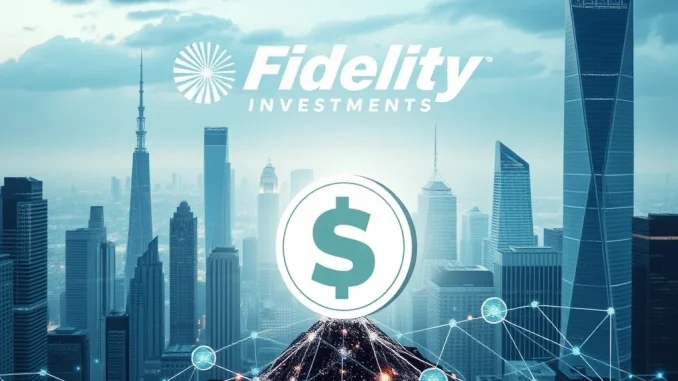
Get ready for a potential game-changer in the world of institutional finance! Fidelity Investments, a financial giant known for its robust investment services, is reportedly preparing to launch its very own stablecoin. This exciting development signals a significant leap forward in the adoption of digital assets by traditional financial institutions and underscores the growing importance of blockchain technology in mainstream finance.
Why is Fidelity Venturing into the Stablecoin Market?
Fidelity’s move into the stablecoin arena isn’t happening in isolation. It’s part of a broader strategy to deepen its involvement in the burgeoning market for tokenized U.S. Treasuries. Think of it as Fidelity expanding its digital asset toolkit to offer clients more versatile and efficient ways to manage and interact with digital currencies. This initiative aligns with the increasing demand for stable and regulated digital currencies within institutional circles.
Here’s a breakdown of what’s driving Fidelity’s push:
- Growing Institutional Demand: Large institutional investors are increasingly seeking exposure to digital assets, but often require the stability and regulatory compliance that stablecoins can offer.
- Tokenized U.S. Treasuries: Fidelity’s interest in stablecoins is directly linked to its foray into tokenized U.S. Treasuries. A stablecoin could facilitate smoother transactions and settlements within this tokenized market.
- Expanding Digital Asset Services: Launching a stablecoin is a natural progression for Fidelity’s digital assets division, allowing them to provide a more comprehensive suite of services to clients interested in crypto and blockchain technologies.
- Competitive Advantage: By offering a proprietary stablecoin, Fidelity can differentiate itself from competitors and attract clients looking for integrated and secure digital asset solutions.
What are Tokenized U.S. Treasuries and Why Do They Matter?
Tokenized U.S. Treasuries are essentially digital representations of U.S. Treasury bonds on a blockchain. Instead of holding traditional bonds, investors can hold tokens that represent ownership of these bonds. This process brings several potential benefits:
| Benefit | Description |
|---|---|
| Increased Efficiency | Transactions and settlements can be faster and more efficient compared to traditional bond markets. |
| Fractional Ownership | Tokenization allows for fractional ownership, making U.S. Treasuries more accessible to a wider range of investors. |
| 24/7 Trading | Unlike traditional markets with set hours, tokenized assets can potentially be traded 24/7. |
| Transparency | Blockchain technology provides greater transparency in transactions and ownership. |
Fidelity’s move to launch a tokenized U.S. money market fund further emphasizes its commitment to this space. This fund, expected to launch by the end of May, will likely utilize the upcoming stablecoin to streamline operations and enhance investor experience.
Challenges and Considerations for Fidelity’s Stablecoin
While the launch of a Fidelity stablecoin is undoubtedly exciting, there are challenges and considerations to keep in mind:
- Regulatory Scrutiny: Stablecoins are under increasing regulatory scrutiny globally. Fidelity will need to navigate complex regulatory landscapes to ensure compliance.
- Security and Trust: Maintaining the security and stability of the stablecoin is paramount to building trust and ensuring widespread adoption.
- Competition: The stablecoin market is becoming increasingly competitive, with established players like Tether (USDT) and Circle (USDC), as well as other institutional entrants.
- Adoption Rate: The success of Fidelity’s stablecoin will depend on its adoption by institutional clients and its integration within the broader digital assets ecosystem.
Actionable Insights: What Does This Mean for You?
For investors and those interested in the crypto space, Fidelity’s stablecoin initiative offers several key takeaways:
- Institutional Adoption is Accelerating: Major financial players like Fidelity are increasingly embracing digital assets, signaling a shift towards mainstream adoption.
- Stablecoins are Becoming Core Infrastructure: Stablecoins are evolving from simple payment tools to essential components of the digital asset infrastructure, facilitating institutional-grade transactions and investments.
- Tokenization is the Future: The tokenization of traditional assets like U.S. Treasuries is gaining momentum, potentially transforming how we interact with financial markets.
- Watch Fidelity’s Next Steps: Keep an eye on Fidelity’s official announcements and the actual launch of their stablecoin and tokenized money market fund for concrete details and implications.
Conclusion: Fidelity’s Stablecoin – A Bold Step into the Future of Finance
Fidelity’s preparation to launch its own stablecoin marks a significant milestone in the evolution of digital assets and their integration into traditional finance. By venturing into stablecoins and tokenized U.S. Treasuries, Fidelity is not just adapting to the changing financial landscape, but actively shaping it. This move could pave the way for greater institutional participation in the crypto market, offering more regulated and stable avenues for exposure to the world of blockchain and digital currencies. As Fidelity pushes forward, the industry will be watching closely to see how this initiative unfolds and what impact it will have on the future of finance.



